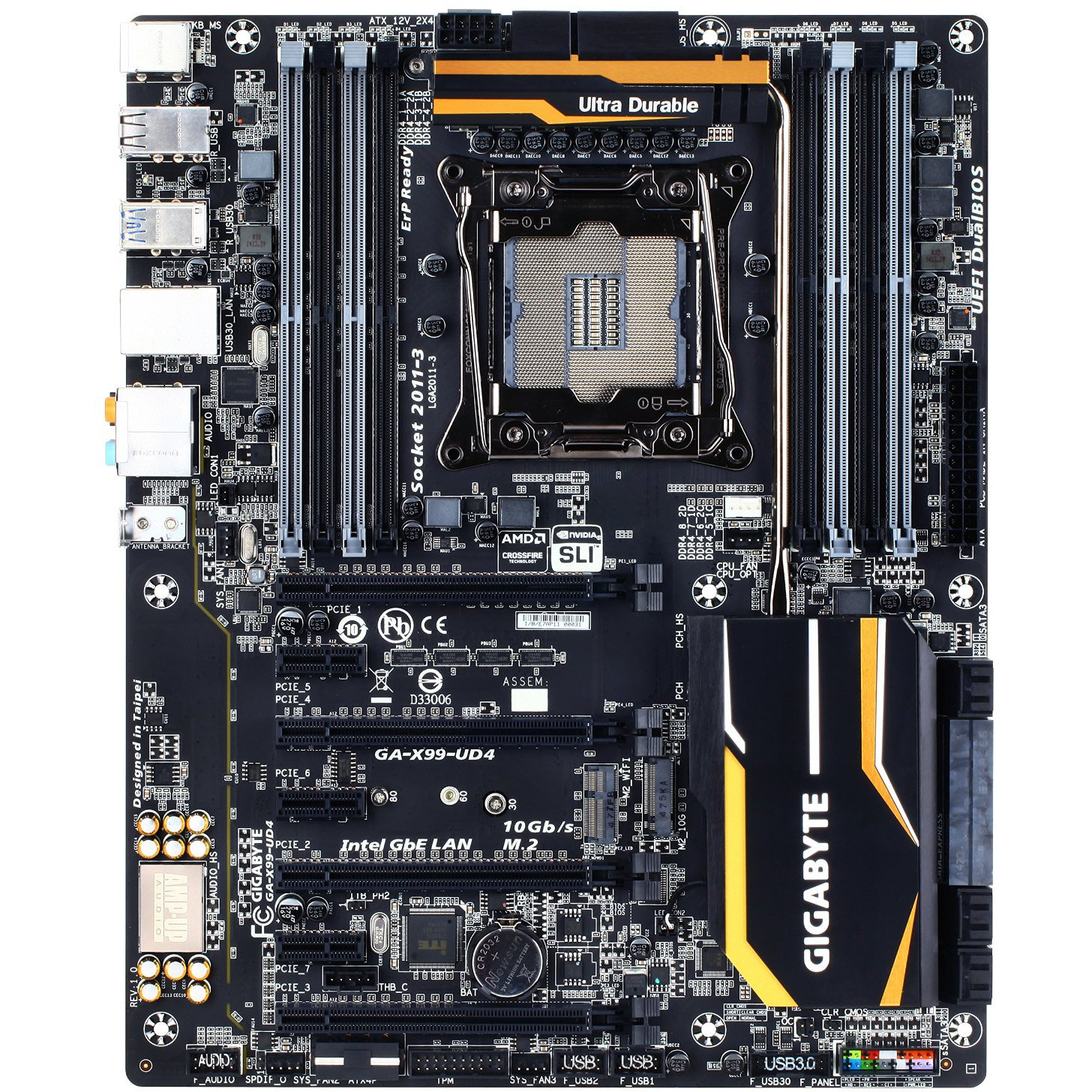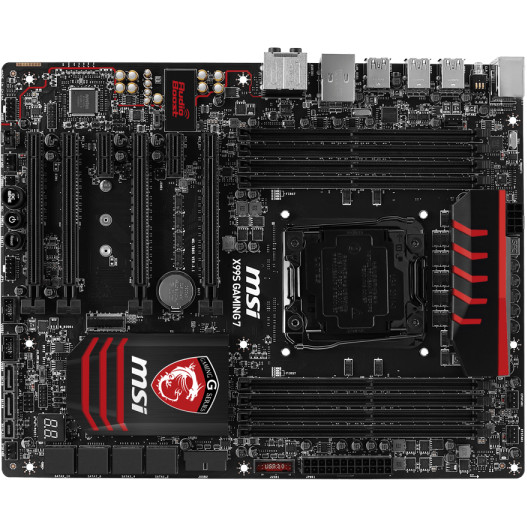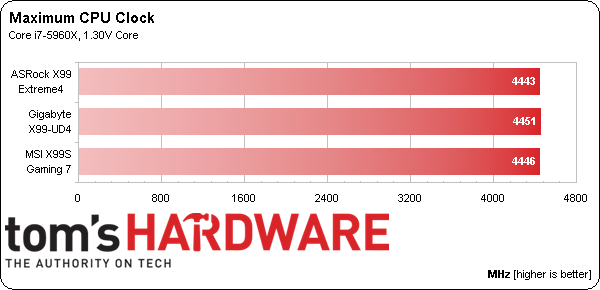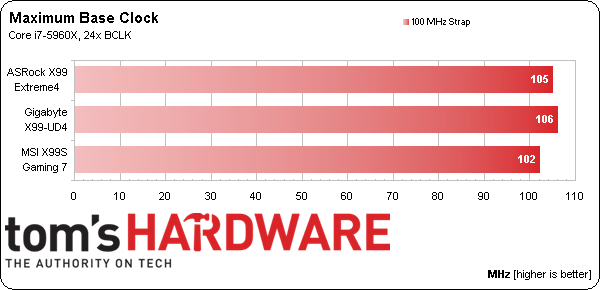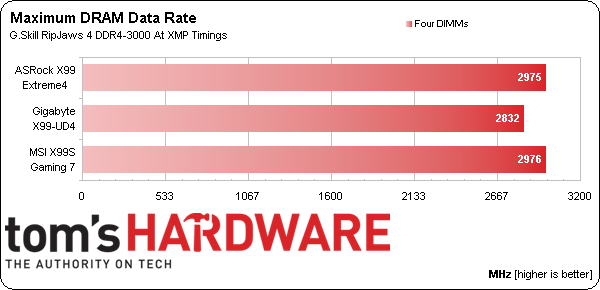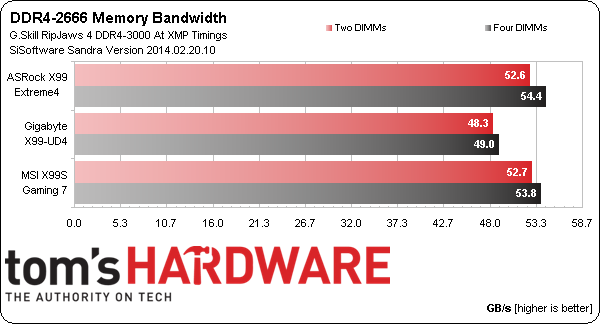Three-Way X99 LGA 2011-v3 ATX Motherboard Shootout
Buyers of Intel's X99 platform, which supports Intel's Haswell-E and new DDR4 memory, were probably prepared to pay a premium for mid-market boards. Are any of these $240 to $300 models worthy of Intel’s latest CPUs?
Results: Overclocking
| BIOS Frequency and Voltage settings (for overclocking) | |||
|---|---|---|---|
| Row 0 - Cell 0 | ASRock X99 Extreme4 | Gigabyte X99-UD4 | MSI X99S Gaming 7 |
| Base Clock | 90-300 MHz (0.1 MHz) | 80-333 MHz (0.01 MHz) | 91-300 MHz (0.05 MHz) |
| CPU Multiplier | 12x-120x (1x) | 12-80x (1x) | 12-80x (1x) |
| DRAM Data Rates | 800-2666 (200/266.6 MHz) | 800-2666 (200/266.6 MHz) | 1333-2666 (200/266.6 MHz) |
| CPU Vcore | 0.80-2.00V (1 mV) | 0.50-1.70V (1 mV) | 0.80-2.10V (1 mV) |
| VCCIN | 1.20-2.30V (10 mV) | 1.00-2.70V (10 mV) | 1.20-3.04V (1 mV) |
| PCH Voltage | 0.90-1.50V (25 mV) | 0.65-1.30V (5 mV) | 0.70-2.32V (10 mV) |
| DRAM Voltage | 1.00-1.80V (10 mV) | 1.00-2.00V (10 mV) | 0.60-2.80V (10 mV) |
| CAS Latency | 4-31 Cycles | 5-31 Cycles | 4-31 Cycles |
| tRCD | 5-31 Cycles | 1-31 Cycles | 4-31 Cycles |
| tRP | 5-31 Cycles | 1-31 Cycles | 4-31 Cycles |
| tRAS | 10-63 Cycles | 1-63 Cycles | 9-63 Cycles |
All three mid-priced X99-based motherboards reach the same 44 x 101 MHz base clock setting, though fractional differences in actual base clock could create the illusion of leadership. We call this a tie.
After seeing that none of the test samples were stable at the 125 MHz needed by our RAM to reach the highest DDR4 data rates, we scratched the test off our list and stuck to a 100 MHz strap. We found that Gigabyte’s X99-UD4 could potentially push a “locked” processor a little further, if Intel ever introduces one.
Not that we’d want to overclock with the X99-UD4, though. Going over the edge caused it to read a firmware error and reflash the chip with an old backup copy. If our hardware required new firmware to function (as sometimes happens after the introduction of a new CPU), we would have been stranded.
Our inability to reach DDR4-3000 at 125 MHz x 24, and Haswell-E’s inability to run 30x data rate ratios meant that we were stuck going backwards from 125 MHz to find each motherboard’s highest data rate, at 124x 24 for both the X99 Extreme4 and X99S Gaming 7. All of those re-flashes on the X99-UD4 eventually pushed us to try the board’s class-leading 106 MHz base clock in conjunction with the CPU’s highest 26.66x data rate multiple, for a grand total of 2832 MT/s.
The lack of a DDR3-2800 setting again forced us to use Haswell-E’s 26.66x maximum memory ratio to find each board’s peak bandwidth. This test was added to a previous platform after finding out that a brand not represented here today was using hobbled timings to win overclocking competitions, but Gigabyte was first to fall behind on this occasion.
Get Tom's Hardware's best news and in-depth reviews, straight to your inbox.
Current page: Results: Overclocking
Prev Page Results: Power, Heat And Efficiency Next Page Picking A Mid-Priced X99 Winner-
west7 In the 3D gaming page it should been i7-5760x not i7-4790 and fix the LGA 2111-v3 typo and why there in no SLI/crossfire test?!Reply -
Daniel Ladishew Can't wait for them to review some of the other manufacturer's products in the X99 category. The ASUS board especially.Reply -
chiefpiggy Noob question: would my socket 1150 i5 4670k work with one of these motherboards or do I need one of the Haswell-E processors?Reply -
sportfreak23 Reply14199415 said:Can't wait for them to review some of the other manufacturer's products in the X99 category. The ASUS board especially.
+1 -
InvalidError Reply
LGA 2011 uses DDR3 while LGA2011-3 uses DDR4 so the sockets are different to prevent people from putting the wrong CPU in the wrong motherboard.14199118 said:"LGA 2111-v3"??
Did something change?
I think there were other changes but this is the big obvious one. -
firefoxx04 it should be mentioned (and maybe it was, just not on the first page) that you only get the 40 pci e lanes if you purchase the two higher tiered haswell-E chips. The lowest end model does not support 40 lanes, I think it supports 28.Reply -
vincevdc The MB grid on page one shows that the MSI X99S Gaming 7 mb has an Intel Z97 Express chipset. This is a typo...Reply

